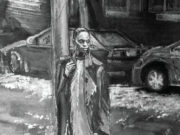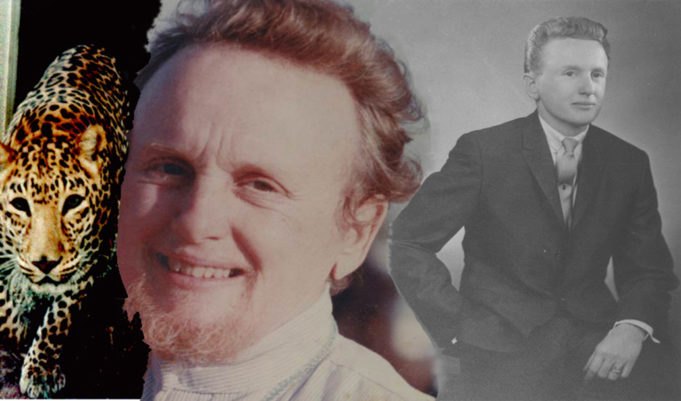 Reed Erickson, née Rita Alma Erickson, was a philanthropist, business scion, engineer. Reed would amass a $40 million fortune in his lifetime, chiefly from investing in oil-rich real estate. Born in El Paso, Texas, October 13, 1917, into a wealthy family, Rita lived the life of privilege.
Reed Erickson, née Rita Alma Erickson, was a philanthropist, business scion, engineer. Reed would amass a $40 million fortune in his lifetime, chiefly from investing in oil-rich real estate. Born in El Paso, Texas, October 13, 1917, into a wealthy family, Rita lived the life of privilege.
 She attended the Philadelphia High School for Girls. Through her adolescence, she would explore her sexuality as a lesbian, and many of her friends and girlfriends would remain close to each other throughout their lives. When the Ericksons moved to Louisiana, she attended LSU, becoming the first girl to graduate the University’s School of Mechanical Engineering.
She attended the Philadelphia High School for Girls. Through her adolescence, she would explore her sexuality as a lesbian, and many of her friends and girlfriends would remain close to each other throughout their lives. When the Ericksons moved to Louisiana, she attended LSU, becoming the first girl to graduate the University’s School of Mechanical Engineering.
The raucous 1950’s saw the rise of HUAC and McCarthyism. These groups discriminated against those believed to support Communism, and also homosexuals. Rita and her lover’s support of Henry Wallace and the blacklisted Paul Robeson, earned them scrutiny by the FBI. Rita was embroiled in FBI surveillance, until her lover fled the country. Rita’s life would be photographed and documented by agents of the US government. It was finally determined that she was never an informant or a supporter of Communism.
A defining moment in Rita’s history occurred while employed at a prestigious scientific institution in Philadelphia. It was discovered that her secretary supported the communist party while living in her Native Germany. The institution’s administration directed Rita to fire the secretary, which she steadfastly refused. Consequentially, Rita and the secretary were both terminated.
Finding it virtually impossible to secure engineering employment, she and her lover moved to Louisiana, then Mexico for nearly 2 years. Retuning to Louisiana, she reemerged herself into her father’s hugely successful businesses, Schuylkill Products Corporation and Schuylkill Lead Corporation. She also started her own business venture, Southern Seating, manufacturing stadium bleachers.
It can be reasonably assumed that she delayed her transition out of affection and respect for her father
When Rita’s father Robert Erickson died in 1962, she inherited a substantial portion of the family business. It can be reasonably assumed that she delayed her transition out of affection and respect for her father.
A year after her father’s death, in 1963, she became a patient of Dr. Harry Benjamin. She started hormone therapy, had a double mastectomy and hysterectomy. By the end of that year, she had legally changed her name to Reed. Two years later in 1965, Reed had his gender change operation at John’s Hopkins University Hospital.

Reed married his second wife, Aileen Ashton that same year after only two dates. The couple had a lavish ceremony in Aileen’s hometown of Christchurch New Zealand. The couple had two children, a adopted son and a daughter by artificial insemination.
He also sold the family business to Arrow corporation for $5 million. His hugely successful Southern Seating venture, coupled with shrewd oil-rich real estate investments catapulted his fortune to $40 million. He used his fortune to great philanthropic advantage.
Establishing the Erickson Educational Foundation(EEF), in 1964, and offering financial and operational support the ONE Inc. to cite two significant organizations. Reed’s alignment with ONE Inc. was significant since it was an organization for homosexual males. Transgender individuals and homosexuals held mutual qualms with each other and Reed’s support didn’t go unnoticed, and managed to ease the distrust on both sides.
To provide assistance and support in areas where human potential was limited by adverse physical, mental, or social conditions, or where the scope of research was too new, controversial or imaginative to receive traditionally oriented support
The EEF’s goal was to, “to provide assistance and support in areas where human potential was limited by adverse physical, mental, or social conditions, or where the scope of research was too new, controversial or imaginative to receive traditionally oriented support.” The EEF backed such influential individuals as Harry Benjamin and John Money.

Reed Erickson was the soul decision maker on the EEF board, as 100% of the foundation was financed by him. This verging megalomaniacal power was soon met with derision by other ‘figurehead’ board members. Regardless of internal derision, the EEF supported virtually every aspect of work in the field of transsexualism in the 1960’s and 1970’s in the U.S. and by extension in other countries as well. Support was realized in the forms of financial and contributions of human and material resources. In 1977, EEF officially ceased operations.
The ground breaking work Reed accomplished with the EEF lead to the formulation of standards of care and the development of the World Professional Association for Transgender Health (WPATH).

Reed was a bit of an eccentric. He owned a pet leopard named Henry. His neighbors in Baton Rouge met his choice of pet with derision. However, there was no legal action to be taken, because at that time, there was no restriction in Louisiana to having a leopard as a pet. He also had the unfortunate flaw of developing an illegal drug dependancy. This would end up being the demise of Reed’s second and third marriage.
Reed was arrested in California for cocaine possession and fled the country. He took up permanent residence in Mexico. His health continued to decline and Reed Erickson died in Mazatlan, Mexico in 1992
citations:
outhistory.org Ada Bello essay
mir, irini, peace, amn,
-jahn
jahn westbrook
Reed’s story is so enlightening. He had contributed so much to the early understanding and discovery of what it is to be transgender. Our community has grown in population and visibility since then. We are on the precipice of societal change. We all have a voice, granted some are louder than others. If we all speak out, together we will have the loudest voice of all.

































